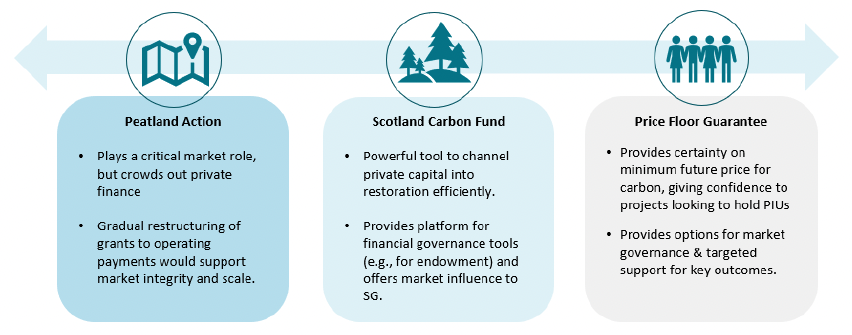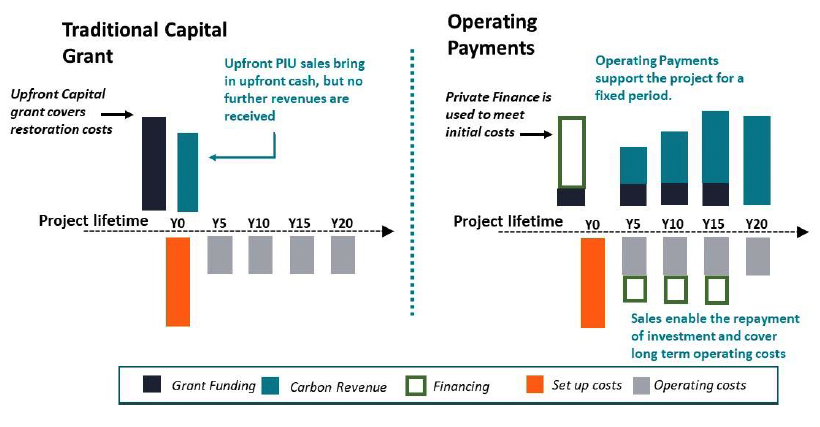Mobilising private investment in natural capital: report
This report looks at how to encourage responsible private investment into peatland restoration, including how to overcome barriers to scaling voluntary carbon markets to restore peatland in Scotland.
Section 9: Building coherence in the peatland financing ecosystem
To function most effectively, the SCF and PFG must be designed as part of a broader financing ecosystem for peatland restoration that is coherent and takes an integrated approach. Without a coherent approach, mechanisms may generate misaligned incentives or reduce the efficiency of public spending.
The funding and financing ecosystem is comprised of all market and public sector financial infrastructure, and requires that mechanisms are designed in parallel to ensure that participants are appropriately incentivised for target behaviours and outcomes.
Designed effectively, a coherent funding financing ecosystem will support high-integrity projects and crowd in private capital at scale. Crowding in private capital will allow for a scale up of delivery, spreading risk effectively, improving transparency and credibility, and unlocking cost efficiencies.
To situate the SCF and PFG within the wider financing ecosystem it is also important to consider existing Peatland ACTION grants, and how these might be re-designed to better align with these mechanisms, and to remove existing barriers to private investment, while also improving financial governance.

Operating Payment: redesigning subsidies
As noted earlier, eligible peatland restoration projects can currently access capital grant funding through the Peatland ACTION programme equivalent to 100% of capital costs.
At current market carbon prices, peatland restoration projects are not viable without partial (and typically substantial) grant funding. However, full capital grants may provide unnecessary subsidies, while not providing support for ongoing project maintenance costs.
As identified through the action research, some stakeholders suggested that capital grants have crowded out private investment, limiting market development. As such, restructuring Peatland ACTION grants to include an ongoing support or "operating" payment could provide a series of key benefits. These payments could be provided alongside a lower capital grant that may be reduced over time as the market matures.
Where desired, or if carbon markets reach sufficient price thresholds, operating payments could be linked to the achievement of specific outcomes or be restricted to projects with specific features or desirable co-benefits (e.g. biodiversity).
Operating Payments are annualised grant payments provided for the operation of a natural capital project. Unlike capital grants, operating payments are made on a recurring basis for a fixed period. The difference between an operating grant and a capital grant is explored below in the illustrative scenario set out in Figure 22. This hypothetical example compares a traditional project using a capital grant and PIU sales to a project using a mix of private finance, operating payments and the ongoing sale of PCUs to meet costs. In practice, a mixed approach providing both capital and grant funding may be most effective in the short term.

The England Woodland Creation Offer (EWCO) scheme represents an example of a mixed capital and operating payment model. Under this model the majority of funding is provided as a capital grant but projects receive a payment of £300 per hectare payment annually for the first ten years of the project. Projects with specific target characteristics (e.g. riparian planting in proximity to population centres) receive additional supplementary grants.
Key considerations
Operating Payments consist of a contract between a grant making body (e.g. Peatland ACTION) and a recipient land owner / tenant. The contract sets out a fixed payment amount, frequency and term. It may be subject to specific conditions (e.g. delivery of specified outcomes). This payment structure provides confidence in project cashflows for a fixed term.
Private investment is suited to the provision of upfront capital (as debt or equity) which assumes risk in the near term on the assumption of future cashflows. Unlike capital grants, Operating Payments encourage projects to seek private financing while de-risking investment. This is particularly beneficial in emerging ecosystem service markets where market-based revenues (e.g. carbon) are highly volatile. Operating Payments help to attract this upfront private finance by lending credibility to the project and by providing assurance that it will generate a predictable cashflow alongside market revenues.
Under this approach, grant payment levels are set on an administrative basis and applied broadly, rather than through market-based mechanisms. This may expose the Scottish Government to risk of incorrect price setting. In addition, contracts represent binding funding obligations, restricting Scottish Government funding flexibility on an annual basis. While commitments are fixed for projects during the life of funding agreements, funding levels can be adjusted over time for new projects to reflect changing market conditions.
Operating Payments can be introduced gradually and refined in the market alongside existing capital grant programmes.
Potential design options
In the short term, alignment to a capital grant programme will allow for a smoother transition from existing funding mechanisms for restoration. As capital grants are reduced, the opportunity for private investment will increase. For example, an initial Operating Payment could be provided alongside a 75% capital grant. Over a period of five to ten years, this could be reduced to a 25% capital grant.
The value of Operating Payments should reflect overall project costs and not be linked directly to periodic costs of maintenance. Initial payments could be linked to the value of the capital grant provided to ensure consistency in the total value of support provided.
Operating Payments may be provided for a fixed period of time, or for the full operating life of the project. While a longer period is beneficial for financial governance (as cashflows are available to meet maintenance costs), this length of liability may be unviable for the grant making authority. A period of 5-20 years will allow projects to hold all, or a portion of, PIUs to a first (or second) period of verification. This will provide projects and landowners a baseline understanding of ongoing costs prior to the sale of carbon credits, as well as the opportunity to establish longer term financial governance arrangements from the sale of verified PCUs at a future price. In addition, this will also provide confidence to investors and carbon buyers of a minimum level of project establishment and permanence.
Grant payments can be varied to reflect specific project characteristics. Under the current Peatland ACTION regime, grant payments are based on the specific capital costs of a project. A grant payment scheme could be similarly bespoke or provide a fixed payment value based on specific project characteristics. Varied payment levels may be used to target specific outcomes (e.g. enhanced biodiversity value).
Operating Payments may be provided on a conditional or outcomes-linked basis. Linking operating payments to the delivery of specified outcomes reduces the risk to Scottish Government of non-delivery, especially in the case of landowner / manager negligence. This is a key benefit compared to unconditional capital grants. The benefits of implementing an outcomes based approach should be weighed up against additional complexity and further verification costs incurred.
Key takeaways
Shifting existing grant funding to an Operating Payments model is a key step in facilitating private finance. The current structure of Peatland ACTION funding has been shown to disincentivise investment to date.
It may be most effective to transition gradually from a capital to an Operating Payment led grant model to ensure continuity. Operating Payments should be provided for an extended period and at a minimum 5 years (first date at which carbon is verified).
Grant payments can be varied to reflect specific project characteristics, and can be used to target specific outcomes.
Table 17 below provides a summary of the risks identified in the development of the Operating Payments concept and how these can be mitigated through the mechanism design.
| Risk |
Mitigations |
|---|---|
| Replacing capital grants with operating payments leads project delivery to stall as the market adjusts |
A staggered and well publicised transition to an Operating Payment led model will allow the market to transition. A period of more generous grants may help ease this transition. This could also include a twin track period where projects can access either grant structure. |
| Projects are unable to access private finance to fill funding gap for delivery |
The implementation of the SCF and PFG alongside the Operating Payments will address this, offering suitable forms of finance to projects. |
| Operating payment levels are set too high, leading to a lower cost effectiveness of public spending |
Operating payment levels can be adjusted for new projects. Some overspending during the transitional period is expected. |
Contact
Email: peter.phillips@gov.scot
There is a problem
Thanks for your feedback